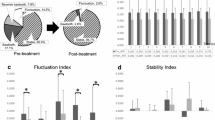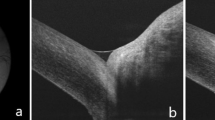Abstract
Purpose
To investigate the characteristics of tear abnormalities with benign essential blepharospasm (BEB) and the effect of botulinum toxin type A (BTX-A) treatment.
Study Design
Prospective and clinical study.
Methods
Forty eyes of 40 patients (12 men and 28 women, ages 63.5 ±12.9) with BEB and tear abnormalities were enrolled.
Results
The average scores for subjective symptoms as evaluated by the visual analog scale (VAS) were 46.3 and Dry Eye-Related Quality-of-Life Score (DEQS) were 63.7. The fluorescein breakup time (FBUT) was 2.7 ± 1.6 sec. Among fluorescein breakup patterns (FBUPs), dimple break, with the corresponding mechanism of decreased wettability was the most frequent, observed in 29 eyes (73%). The NEI score was 0.4 ± 0.7 and the van Bijesterveld score was 0.6 ± 0.8; the Schirmer 1 test value was 13.1 ± 9.4 mm. Eighteen patients received BTX-A treatment, and significant improvement was found in severity of subjective symptoms both on VAS and DEQS as well as for FBUT. The main FBUPs changed from dimple break to random break.
Conclusion
Tear abnormalities seen in BEB correspond to short BUT-type dry eye (DE), subclassified into decreased wettability DE in view of FBUPs.




Similar content being viewed by others
References
Lu R, Huang R, Li K, Zhang X, Yang H, Quan Y, et al. The influence of benign essential blepharospasm on dry eye disease and ocular inflammation. Am J Ophthalmol. 2014;157:591–7.
Grandas F, Elston J, Quinn N, Marsden CD. Blepharospasm: a review of 264 patients. J Neurol Neurosurg Psychiatry. 1988;51:767–72.
Defazio G, Livrea P. Primary blepharospasm: diagnosis and management. Drugs. 2004;64:237–44.
Anderson RL, Patel BC, Holds JB, Jordan DR. Blepharospasm: past, present, and future. Ophthal Plast Reconstr Surg. 1998;14:305–17.
Tsubota K, Fujihara T, Kaido M, Mori A, Mimura M, Kato M. Dry eye and Meige’s syndrome. Br J Ophthalmol. 1997;81:439–42.
Wakakura M, Inoue J. Application of new Japanese version of diagnostic criteria for dry eye to essential blepharospasm. Rinsho Ganka. 2008;62:857–60 (in Japanese).
Park DI, Shin HM, Lee SY, Lew H. Tear production and drainage after botulinum toxin A injection in patients with essential blepharospasm. Acta Ophthalmol. 2013;91:e108–12.
Tsubota K, Yokoi N, Shimazaki J, Watanabe H, Dogru M, Yamada M, et al. New perspectives on dry eye definition and diagnosis: a consensus report by the Asia Dry Eye Society. Ocul Surf. 2017;15:65–76.
Toda I, Fujishima H, Tsubota K. Ocular fatigue is the major symptom of dry eye. Acta Ophthalmol (Copenh). 1993;71:347–52.
Koh S, Maeda N, Hori Y, Inoue T, Watanabe H, Hirohara Y, et al. Effects of suppression of blinking on quality of vision in borderline cases of evaporative dry eye. Cornea. 2008;27:275–8.
Shimazaki-Den S, Iseda H, Dogru M, Shimazaki J. Effects of diquafosol sodium eye drops on tear film stability in short BUT type of dry eye. Cornea. 2013;32:1120–5.
Koh S. Clinical utility of 3% diquafosol ophthalmic solution in the treatment of dry eyes. Clin Ophthalmol. (Auckl., NZ). 2015;9:865–72.
Yokoi N, Georgiev GA. Tear film-oriented diagnosis and tear film-oriented therapy for dry eye based on tear film dynamics. Investig Ophthalmol Vis Sci. 2018;59:Des13–des22.
Yokoi N, Georgiev GA. Tear-film-oriented diagnosis for dry eye. Jpn J Ophthalmol. 2019;63:127–36.
Yokoi N, Georgiev GA, Kato H, Komuro A, Sonomura Y, Sotozono C, et al. Classification of fluorescein breakup patterns: a novel method of differential diagnosis for dry eye. Am J Ophthalmol. 2017;180:72–85.
Yokoi N, Kato H, Kinoshita S. The increase of aqueous tear volume by diquafosol sodium in dry-eye patients with Sjogren’s syndrome: a pilot study. Eye (Lond, Engl). 2016;30:857–64.
Sakane Y, Yamaguchi M, Yokoi N, Uchino M, Dogru M, Oishi T, et al. Development and validation of the Dry Eye-Related Quality-of-Life Score questionnaire. JAMA Ophthalmol. 2013;131:1331–8.
Koh S, Watanabe H, Hosohata J, Hori Y, Hibino S, Nishida K, et al. Diagnosing dry eye using a blue-free barrier filter. Am J Ophthalmol. 2003;136:513–9.
Lemp MA. Report of the National Eye Institute/Industry workshop on clinical trials in dry eyes. CLAO J. 1995;21:221–32.
van Bijsterveld OP. Diagnostic tests in the Sicca syndrome. Arch Ophthalmol. (Chic Ill : 1960). 1969;82:10–4.
Guideline of clinical practice for blepharospasm. Nippon Ganka Gakkai zasshi. 2011;115:617–28. (in Japanese).
Jankovic J, Havins WE, Wilkins RB. Blinking and blepharospasm. Mechanism, diagnosis, and management. JAMA. 1982;248:3160–4.
Yokoi N, Uchino M, Uchino Y, Dogru M, Kawashima M, Komuro A, et al. Importance of tear film instability in dry eye disease in office workers using visual display terminals: the Osaka study. Am J Ophthalmol. 2015;159:748–54.
Shimazaki J, Tsubota K, Kinoshita S, Oohashi Y, Shimomura Y, Tagawa Y, et al. Definition and diagnosis of dry eye 2006. Atarashii Ganka. 2007;24:181–4 (in Japanese).
Yang J, Shao N, Song W, Wei Q, Ou R, Wu Y, et al. Nonmotor symptoms in primary adult-onset cervical dystonia and blepharospasm. Brain Behav. 2017;7:e00592. https://doi.org/10.1002/brb3.592.
Bedarf JR, Kebir S, Michelis JP, Wabbels B, Paus S. Depression in blepharospasm: a question of facial feedback? Neuropsychiatr Dis Treat. 2017;13:1861–5.
Evinger C, Bao JB, Powers AS, Kassem IS, Schicatano EJ, Henriquez VM, et al. Dry eye, blinking, and blepharospasm. Mov Disord. 2002;17(Suppl 2):S75–8.
Argueso P, Spurr-Michaud S, Russo CL, Tisdale A, Gipson IK. MUC16 mucin is expressed by the human ocular surface epithelia and carries the H185 carbohydrate epitope. Investig Ophthalmol Vis Sci. 2003;44:2487–95.
Gipson IK, Spurr-Michaud S, Tisdale A, Menon BB. Comparison of the transmembrane mucins MUC1 and MUC16 in epithelial barrier function. PloS One. 2014;9:e100393. https://doi.org/10.1371/journal.pone.0100393.
Guidelines for clinical practice for dry eye. Nippon Ganka Gakkai Zasshi. 2019;123:489–592 (in Japanese).
Knop E, Korb DR, Blackie CA, Knop N. The lid margin is an underestimated structure for preservation of ocular surface health and development of dry eye disease. Dev Ophthalmol. 2010;45:108–22.
Snir M, Weinberger D, Bourla D, Kristal-Shalit O, Dotan G, Axer-Siegel R. Quantitative changes in botulinum toxin a treatment over time in patients with essential blepharospasm and idiopathic hemifacial spasm. Am J Ophthalmol. 2003;136:99–105.
Ababneh OH, Cetinkaya A, Kulwin DR. Long-term efficacy and safety of botulinum toxin A injections to treat blepharospasm and hemifacial spasm. Clin Exp Ophthalmol. 2014;42:254–61.
Gunes A, Demirci S, Koyuncuoglu HR, Tok L, Tok O. Corneal and tear film changes after botulinum toxin-A in blepharospasm or hemifacial spasm. Cornea. 2015;34:906–10.
Kocabeyoglu S, Sekeroglu HT, Mocan MC, Muz E, Irkec M, Sanac AS. Ocular surface alterations in blepharospasm patients treated with botulinum toxin A injection. Eur J Ophthalmol. 2014;24:830–4.
Sahlin S, Chen E, Kaugesaar T, Almqvist H, Kjellberg K, Lennerstrand G. Effect of eyelid botulinum toxin injection on lacrimal drainage. Am J Ophthalmol. 2000;129:481–6.
Ho RW, Fang PC, Chao TL, Chien CC, Kuo MT. Increase lipid tear thickness after botulinum neurotoxin A injection in patients with blepharospasm and hemifacial spasm. Sci Rep. 2018;8:8367.
Isshiki Y, Ishikawa H, Mimura O. Changes in ocular higher-order aberrations following botulinum toxin treatment in patients with blepharospasm : BTX improves dry eye in patients with BEB. Jpn J Ophthalmol. 2016;60:486–91.
Acknowledgement
We thank Dr. Robert Latta for editing the English of the manuscript.
Author information
Authors and Affiliations
Corresponding author
Ethics declarations
Conflicts of interest
Y. Hosotani, None; N. Yokoi, Lecture Fee (Santen, Otsuka), Consultant fee (Rhoto, Alcon); M. Okamoto, None; H. Ishikawa, None; A. Komuro, None; H. Kato, None; O. Mimura, Lecture fee (TEIJIN, Santen), Speaker fee (Senju, Novartis, KOWA Pharmaceutical, GlaxoSmithKline, Otsuka, Sumitomo Dainippon, Pfizer); F. Gomi, Grant (Pfizer, Alcon, Novartis, Otsuka), Lecture fee (Santen, Senju, GlaxoSmithKline), Speaker fee (Bayer).
Additional information
Publisher's Note
Springer Nature remains neutral with regard to jurisdictional claims in published maps and institutional affiliations.
Corresponding Author: Yuka Hosotani
About this article
Cite this article
Hosotani, Y., Yokoi, N., Okamoto, M. et al. Characteristics of tear abnormalities associated with benign essential blepharospasm and amelioration by means of botulinum toxin type A treatment. Jpn J Ophthalmol 64, 45–53 (2020). https://doi.org/10.1007/s10384-019-00705-3
Received:
Accepted:
Published:
Issue Date:
DOI: https://doi.org/10.1007/s10384-019-00705-3




